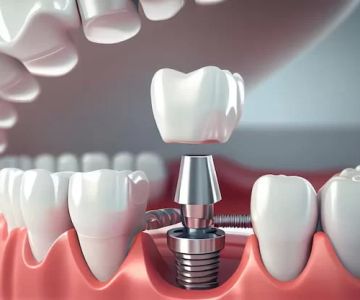- Overview of the Healing Process
- Stage 1: Immediate Post-Op Care
- Stage 2: The Osseointegration Phase
- Stage 3: Long-Term Healing and Maintenance
- Potential Complications and How to Avoid Them
Overview of the Healing Process
After dental implant surgery, patients typically experience a healing process that spans several months. The success of the surgery heavily depends on how well patients follow the post-op care instructions. Proper care can ensure that the implant integrates with the jawbone, a process known as osseointegration, which is crucial for the implant’s long-term stability.
Understanding each phase of the healing process is essential to managing expectations and taking the necessary steps for recovery. This guide will walk you through the stages of healing after dental implant surgery and offer tips to make your recovery as smooth as possible.
Stage 1: Immediate Post-Op Care
The first stage of healing begins immediately after surgery. During this period, the focus is on minimizing discomfort, preventing infection, and ensuring that the implant site remains undisturbed. Here are some key aspects of the immediate recovery phase:
- Swelling and Pain Management: It is common to experience swelling and discomfort for the first few days. Ice packs and prescribed pain relievers can help manage these symptoms.
- Dietary Restrictions: A soft-food diet is recommended for at least the first week to avoid putting stress on the implant site.
- Oral Hygiene: Proper oral hygiene is critical during this phase. Gently rinsing with warm salt water can help keep the surgical area clean without disturbing the implant.
Patients should expect some level of swelling and bruising during this stage. These are normal side effects and typically subside within a few days to a week.
Stage 2: The Osseointegration Phase
The osseointegration phase is perhaps the most important part of the healing process. This is when the implant begins to fuse with the jawbone, which can take anywhere from three to six months. During this phase, patients need to avoid putting too much pressure on the implant to ensure successful integration.
Key considerations during this phase include:
- Follow-Up Appointments: Regular visits to the dentist will ensure that the implant is healing properly. The dentist will monitor the progress of osseointegration through X-rays and other diagnostic tools.
- Avoiding Hard Foods: Chewing hard foods or putting excessive pressure on the implant can disrupt the healing process. Stick to soft foods and avoid chewing directly on the implant site.
- Bone Health: Bone health is crucial for successful osseointegration. Ensuring adequate calcium intake and following any additional instructions provided by the dentist will help support the healing process.
During this time, it’s vital to be patient and follow your dentist’s recommendations closely to give the implant the best chance of success.
Stage 3: Long-Term Healing and Maintenance
Once the implant has successfully fused with the bone, the healing process moves into its final stage. This phase involves both the soft tissue and the ongoing maintenance of the implant. Patients should take the following actions during this phase:
- Final Restoration: After osseointegration is complete, a permanent crown or other restoration will be placed on the implant. This is typically done in one or two visits to the dentist.
- Regular Checkups: Even after the implant is fully healed, regular dental checkups are essential to monitor the health of the implant and surrounding tissues.
- Proper Oral Care: Maintain excellent oral hygiene to prevent infection around the implant. Brushing, flossing, and using mouthwash as recommended will keep your implant site healthy.
During this phase, you may resume normal eating and speaking habits. It’s important to remember that regular maintenance and proper care are crucial to the long-term success of the dental implant.
Potential Complications and How to Avoid Them
While dental implants have a high success rate, there are potential complications that can arise. These include infection, implant failure, and damage to surrounding teeth or nerves. Here are a few steps to help avoid these complications:
- Follow Post-Op Care Instructions: Strictly adhere to your dentist's post-operative care guidelines to avoid infection or disruption of the healing process.
- Monitor for Infection: If you experience prolonged pain, swelling, or discharge from the implant site, contact your dentist immediately as these could be signs of infection.
- Quit Smoking: Smoking can interfere with the healing process and increase the risk of implant failure. It's highly recommended to quit or limit smoking during the healing period.
By taking the right precautions and staying informed, most patients can enjoy a successful healing process and the benefits of their new dental implant.







 Fine Dental Care4.0 (373 review)
Fine Dental Care4.0 (373 review) Perry Street Dental5.0 (200 review)
Perry Street Dental5.0 (200 review) Westridge Dental Group: Kasper Robert DDS4.0 (11 review)
Westridge Dental Group: Kasper Robert DDS4.0 (11 review) River Run Dental4.0 (1958 review)
River Run Dental4.0 (1958 review) Norton Family Dental4.0 (747 review)
Norton Family Dental4.0 (747 review) Dr. Michael P. Rutz, DMD5.0 (22 review)
Dr. Michael P. Rutz, DMD5.0 (22 review) The Importance of Oral Health Education During Pregnancy for a Healthy Pregnancy
The Importance of Oral Health Education During Pregnancy for a Healthy Pregnancy Best Tips for Brushing Your Teeth Properly for Healthy Gums: Essential Techniques for Oral Health
Best Tips for Brushing Your Teeth Properly for Healthy Gums: Essential Techniques for Oral Health Why Skipping Dental Checkups Can Lead to Bigger Oral Health Problems
Why Skipping Dental Checkups Can Lead to Bigger Oral Health Problems Advantages of Porcelain Dental Restorations
Advantages of Porcelain Dental Restorations How Can Diabetes Cause Tooth and Gum Problems? Preventing and Managing Oral Health Issues
How Can Diabetes Cause Tooth and Gum Problems? Preventing and Managing Oral Health Issues Healthy Habits for Promoting Good Oral Health and Hygiene: Tips for a Healthy Smile
Healthy Habits for Promoting Good Oral Health and Hygiene: Tips for a Healthy Smile